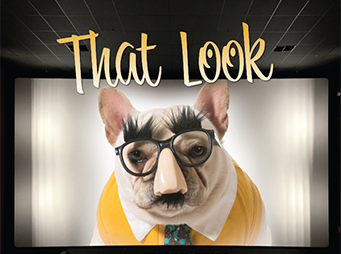That Look! – How Dogs Use Their Eyebrows to Communicate
Click here to read the complete article
186 – September 2019
By Amy Fernandez
Even though we’ve been hanging out with them for thousands of years, there’s plenty we don’t know about how or why dogs took up residence in our world. These days, much of that discussion is steamrolled by AR rhetoric about animal enslavement. In spite of that distraction, research continues to unearth astounding clues about this long, intimate partnership.
But let’s get to the point. The canine ability to accurately interpret human mannerisms is not news. Despite our best attempts at subterfuge, our dogs seem able to predict every damn thing we’re up to… going to the fridge…or worse yet, the car? It’s impossible to sneak anything past them. Over the past decade, academia has confirmed that the canine brain is organized much like our own, with sectors devoted to logical and sensory reckoning.
So contrary to much of what you read on the internet, they do not have supernatural ability. The rational scientific explanation for their talent defines it as a mechanistic adaptive response. In other words, dogs learn to read and interpret our subtlest intention cues simply because it furthers their opportunistic agenda in our neighborhood.
Well, the latest news, as reported in the June 18 New York Times, blows that theory right to hell because it turns out that dogs are equipped with a strange bit of anatomy that is lacking in their wolfish ancestors.
You know when your dog gives you “that look”, that puzzled/concerned/totally aware reaction to whatever mental meltdown you are currently experiencing?? Or sandwich you’re not planning to share. The wrinkly forehead, the cocked head, the adorable raised eyebrow? That’s when you know for sure that this four-footed bedmate is on your wavelength. Well, this age-old spooky phenomenon has finally broken through and gained the attention of real scientists. Yeah, we have cracked the code on this part of the deal.
Officially dubbed AU101 by a team of evolutionary psychologists, a June 17 report in Proceedings of the National Academy of Sciences confirmed that dogs utilize this singular facial expression far more often and way better than wolves mainly because, as anatomical research has so far confirmed, they possess a previously unknown facial muscle, the levator anguli occli medaialis, that was apparently added to the canine blueprint sometime during the wolf to dog transition.
Although wolves are capable of a range of facial expressions, they lack the tiny, levator muscle required for this one. Even more fascinating, they discovered that it is much less developed in very ancient breeds, like Siberian Huskies, that are more closely related wolves. The project is currently investigating the extent of this trait in various modern breeds. Regardless of that, we’ve all got dogs that use “the look” to their advantage for every conceivable purpose.
We still don’t know why it evolved, but the popular theory suggests that it was an evolutionary add-on. Ancient humans simply preferred the company of empathetic, responsive canines. Therefore, the anatomical quirk endured and intensified as part of the domestication package.
As noted, our current knowledge of dog domestication has barely scratched the surface. Although genome reconstruction has opened new doors as far as understanding the mechanics of wolf/dog hybridization, there are still way more questions than answers about that critical evolutionary split which could have occurred anywhere from 27,000-40,000 years ago.
No part of this story is cut and dried. Plenty of research, genetic and otherwise, suggests that it mostly falls into the category of nature simply taking its course. So, even though domestication is an extremely rare phenomenon, we definitely know that dogs evolved from multiple wolf lineages in geographically disparate locations in both Europe and East Asia. Despite the odds against all that, they still somehow developed this strange little muscle that serves no other purpose than facilitating interspecies interaction? Even in that sense, this anatomical quirk is hard to explain from a Darwinian standpoint. Its only biological function seems to be communicating with our species.
Interspecies communication is common throughout the animal kingdom, but it’s generally limited to instinctive, predictable signals simply because the correlation between intention and action is straightforward. There is only one exception to that rule…
As you know, our brains are always locked in a battle between logic and emotion. The resultant unpredictable nature of our thinking has equipped us with a dangerous blend of intellectual advantage and natural craftiness. Very often, what we say is drastically different from what we do, which is good most of the time. You might want to kill the guy stealing your parking spot but, lucky for him, you don’t. Even so, your body language lets him know that you were one step away from going psycho. Anyway, ongoing socialization hones our ability to scan and interpret those subtle clues in our fellow beings.
Research has confirmed that dogs are also capable of this sophisticated type of visceral response to illogical, asymmetrical human communications. They not only discovered how to decipher our bizarre social signals, part of this learned evolutionary strategy included figuring out HOW to do it for maximum results. As researchers have discovered, just like us, they instinctively recognize inherent patterns of asymmetrical brain activation (AKA left gaze bias) to accurately gauge intention.
However, this latest discovery takes it to a whole new level. Interpreting human signals is one thing; developing the ability to mimic them, well…it didn’t happen overnight but it sure adds some insight to the uncanny rapport that exists between our species.
Dog domestication might be called a megamerger between two predatory rivals at the top of the food chain. This ongoing interaction probably bounced back and forth between competition and cooperation for thousands of years until it finally led to the current relationship between our species. For both our species, the subsequent survival benefits revised every aspect of life on this planet in ways that are so entrenched in evolutionary history that we don’t even consider them.
This latest surprising discovery is more validation that science has vastly underestimated the parameters of canine perception. And it has some fascinating implications. It should, hopefully, neutralize the currently popular trope portraying this wolf to dog transformation as genetic degeneracy. Of course, that defies common sense to begin with, since wolves generally fall into the category of rare/endangered/extinct whereas dogs seem to abound everywhere–whether they are appreciated or not.
I’ll leave you with this thought. The intricacies of human/canine communication have gained academic traction in recent years. In many ways, it’s like we’re locked into an endless global, social experiment. And although we still don’t know exactly how long this partnership has been going on, it has unquestionably reached a new intensity in the last couple hundred years. Now, if this keeps up, and dogs continue on their successful evolutionary trajectory, just imagine what they might be cooking up next. Just sayin’.
Click here to read the complete article
186 – September 2019
Short URL: https://caninechronicle.com/?p=170042
Comments are closed












